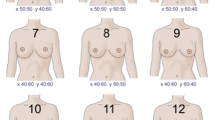Abstract
Introduction
The navel contributes to abdominal surface identity and beauty. In Western societies, the display of the navel in women’s fashion has grown and, nowadays, women are much more concerned about its shape and position. Despite this, few studies are available on navel surface anatomy and there is no standardization regarding its proper placement in cosmetic abdominoplasty.
Materials and Methods
In this observational study, we analyzed navel shape and position on 81 high quality pictures, having been chosen as top 2013 bikini models by editors of mass media. An on-line survey on navel shape and position has been made via facebook.com, involving 1,682 people.
Results
The analysis revealed that navel position is quite variable based on the proportions analyzed with an acceptable narrow data spread of the xiphoid–umbilicus:umbilicus-abdominal mean crease ratio of 1.62 ± 0.16. The data dispersion for the other three ratios was wider, making them less reliable as references. The most appreciated navel shape was the vertical oval with superior hooding (82 %), and the less appreciated ones were the horizontal oval (29 %) and the protruding shape (47 %). When comparing navel position on the same body, the majority of participants choose the one with the navel relocated according to the golden ratio (i.e., 1.618)
Conclusion
The most attractive navel position is located at the xiphoid–umbilicus:umbilicus-abdominal crease golden ratio. Bony landmarks seem to be not reliable as references for proper navel positioning. The use of the Fibonacci (golden mean) caliper intraoperatively might aid in proper positioning of the navel in abdominoplasty.
No Level Assigned
This journal requires that authors assign a level of evidence to each submission to which Evidence-Based Medicine rankings are applicable. This excludes Review Articles, Book Reviews, and manuscripts that concern Basic Science, Animal Studies, Cadaver Studies, and Experimental Studies. For a full description of these Evidence-Based Medicine ratings, please refer to the Table of Contents or the online Instructions to Authors http://www.springer.com/00266.






Similar content being viewed by others
References
Vernon S (1957) Umbilical transplantation upward and abdominal contouring in lipectomy. Am J Surg 94(3):490–492
Pitanguy I (1975) Abdominal lipectomy. Clin Plast Surg 2(3):401–410
Baroudi R (1975) Umbilicoplasty. Clin Plast Surg 2:431
Hinderer UT (1975) The dermolipectomy approach for augmentation mammaplasty. Clin Plast Surg 2(3):359–369
Dubou R, Ousterhout DK (1978) Placement of the umbilicus in an abdominoplasty. Plast Reconstr Surg 61(2):291–293
Craig SB, Faller MS, Puckett CL (2000) In search of the ideal female umbilicus. Plast Reconstr Surg 105:389
Sakamoto Y, Kamagata S, Hirobe S, Hayashi A (2010) Umbilical shape by age and growth: a Japanese study. Plast Reconstr Surg 126(2):97e–98e
Choudhary S, Taams KO (1998) Umbilicosculpture: a concept revisited. Br J Plast Surg 51:538
Rohrich RJ, Sorokin ES, Brown SA, Gibby DL (2003) Is the umbilicus truly midline? Clinical and medicolegal implications. Plast Reconstr Surg 112(1):259–263
Abhyankar SV, Rajguru AG, Patil PA (2006) Anatomical localization of the umbilicus: an Indian study. Plast Reconstr Surg 117(4):1153–1157
Parnia R, Ghorbani L, Sepehrvand N, Hatami S, Bazargan-Hejazi S (2012) Determining anatomical position of the umbilicus in Iranian girls, and providing quantitative indices and formula to determine neo-umbilicus during abdominoplasty. Indian J Plast Surg. 45(1):94–96
Matarasso A, Wallach SG (2001) Abdominal contour surgery: treating all aesthetic units, including the mons pubis. Aesthet Surg J. 21(2):111–119
Mendieta CG (2011) Evaluation based on anatomic landmarks. In: Karen B (ed) The art of gluteal sculpting. Quality Medical Publishing Inc., St Louis, pp 3–109
Levin EI (1978) Dental esthetics and the golden proportion. J Prosthet Dent 40(3):244–252
Bruekers SE, van der Lei B, Tan TL, Luijendijk RW, Stevens HP (2009) “Scarless” umbilicoplasty: a new umbilicoplasty technique and a review of the English language literature. Ann Plast Surg 63:15–20
Conflict of interest
None of the authors has a financial interest in any of the products, devices, or drugs mentioned in this manuscript.
Author information
Authors and Affiliations
Corresponding author
Rights and permissions
About this article
Cite this article
Visconti, G., Visconti, E., Bonomo, L. et al. Concepts in Navel Aesthetic: A Comprehensive Surface Anatomy Analysis. Aesth Plast Surg 39, 43–50 (2015). https://doi.org/10.1007/s00266-014-0434-z
Received:
Accepted:
Published:
Issue Date:
DOI: https://doi.org/10.1007/s00266-014-0434-z




